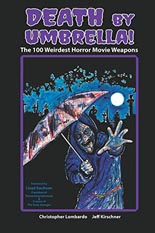 In our book Death by Umbrella! The 100 Weirdest Horror Movie Weapons, we sought to chronicle some of the weirdest, wackiest, most creative, strangest and sometimes just plain silliest implements used in horror movies to snuff out a life. Writing and researching the book allowed us to revisit some of our favorite movies as well as to discover hidden gems in what we consider to be one of the most malleable and creatively fertile of all the genres. It also allowed us to luridly wallow in all those viscerally exciting deaths!
In our book Death by Umbrella! The 100 Weirdest Horror Movie Weapons, we sought to chronicle some of the weirdest, wackiest, most creative, strangest and sometimes just plain silliest implements used in horror movies to snuff out a life. Writing and researching the book allowed us to revisit some of our favorite movies as well as to discover hidden gems in what we consider to be one of the most malleable and creatively fertile of all the genres. It also allowed us to luridly wallow in all those viscerally exciting deaths!
It’s not all about the morbidity; please don’t think that. Horror is more than just cheap thrills. That’s not to decry cheap thrills, mind you. Cheap can sometimes be good! On certain occasion, a fine wine is required. At other times, a bottle of bottom-of-the-shelf plonk will fit the bill quite nicely. Depending on the film, horror is either a fine chateaubriand or a greasy takeout bag full of Mickey D’s. But at its best, horror serves a higher function. The genre forces us to own up to our absolute mortality (last we checked, still 100 percent for humans). Horror also holds a mirror up to the darker elements of society, which, like it or not, exist. And by exposing ourselves to the darkness, we can then better appreciate the light. Horror allows us to adjust ourselves accordingly to the world we live in, which, let’s face it, is often more horrific than the umpteenth slasher sequel unspooling at the local multiplex (or supernatural spookfest because, really, there hasn’t been a good mainstream slasher made in at least the last 20 years).
But back to the kills! Sometimes it’s just plain fun to watch some annoying prankster or nubile coed going to that great gig in the sky. Stephen King likens it to “lifting a trap door in the civilized forebrain and throwing a basket of raw meat to the hungry alligators swimming around in that subterranean river beneath.” And who are we to argue with the King? So to keep those gators fed, we watch horror movies. In our book, we examine some of the more outré kills, but not every satisfying kill in a horror movie is unconventional (although can being ripped apart by zombies really be described as conventional?) What follows are some favorite horror kills that, for the fact that they were deemed too orthodox, didn’t make it into our book. They may be more workaday than, say, death by eggbeater (as seen in Pledge Night), but that doesn’t make them any less awesome. Back into the depths of a coroner’s nightmare we go!
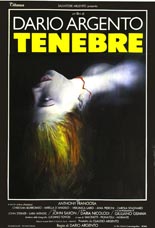 1. Tenebre (1982)
1. Tenebre (1982)
Dario Argento, in his prime (beginning with his first film, 1971’s The Bird with the Crystal Plumage and ending, arguably, with 1987’s lush Opera) was nigh untouchable. The director, dubbed “The Italian Hitchcock,” was famous for his giallos, ostensibly murder mysteries featuring a black-gloved killer. Argento’s best films were meticulous, virtuosic, painfully gorgeous manslaughter masterpieces which elevated horror to something more akin to fine art.
Tenebre was the first Argento film I saw, and immediately, I knew that I had found my new favorite director. The film tells the tale of American book writer Peter Neal, who, on a promotional visit to Rome, has to contend with a serial killer both stalking him and offing others along the way. All the Argento hallmarks are present and accounted for: the aforementioned black-gloved killer, a pounding musical score by Goblin, impeccable camerawork and without-peer transcendent murder set-pieces. One of those kills, “Death by Abstract Metal Sculpture,” made it into our book. But it was another particular kill that blew me away during my first rendezvous with the master — and you always remember your first!
Argento was never a director known for his gore. True, his films could never be described as “tame,” but for the real juicy, squishy stuff, one would be better served with the oeuvre of Italian contemporary Lucio Fulci. But Tenebre does feature one of the maestro’s goriest kills. Late in the film, Neal’s estranged wife, Jane, who has made her way to Rome, is distraught and suicidal when speaking with Neal’s assistant Anne. Anne tells Jane to stay put so she can come over to assist. Unfortunately for Jane, Anne does not make it in time. As Jane is sitting at the kitchen table, an ax breaks through the window and hacks Jane’s wrist and hand clean off. Jane clutches her arm as an arterial spray paints the kitchen walls a beautiful shade of crimson. A few more swings of the ax and the song is over for poor, sweet Jane.
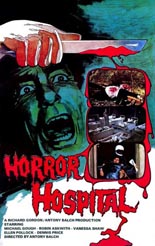 2. Horror Hospital (1973)
2. Horror Hospital (1973)
Who doesn’t like a good beheading? Other than Marie Antoinette that is. Films as diverse as The Omen, The Evil Dead, High Tension, Re-Animator and even Werner Herzog’s Aguirre, the Wrath of God have featured memorable instances of people literally losing their heads. But it’s the double decapitation in this 1973 British import which, for some odd reason, has always stayed with me. (I guess you can say, to quote ELO, I can’t get it out of my head. Okay … that’s it for head humor. At least in this paragraph, that is.)
The film begins with a luxury vehicle parked in the pastoral English countryside. In the back sits the nefarious, black-clad Dr. Christian Storm (played by the wonderful Michael Gough). Next to him sits his dwarfish companion, Frederick. Suddenly, the agrarian serenity is broken when two youths, covered in blood and holding hands, frantically break through the bush. “Now make a clean job of it, Frederick. The car was washed this morning,” implores Storm. The car goes into gear, Storm cries “Now,” and Frederick pulls a lever.
A large blade then protrudes from the side of the vehicle, which stops the two runners dead in their tracks as their domes are cut clean off and fall into an awaiting basket. The would-be-escapees are next seen lying on the ground, but two bloody stumps where their grey matter used to reside as the car makes a quick getaway. So much for the young trying to get ahead in this world. (Sorry! Couldn’t resist.)
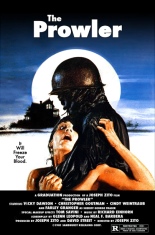 3. The Prowler (1981)
3. The Prowler (1981)
A somewhat unremarkable slasher released right in the thick of the stalk and slash boom, 1981’s The Prowler (aka Rosemary’s Killer, aka Pitchfork Massacre) still earns points for two successful shots on goal. First, it introduced director Joseph Zito to the gatekeepers of the Friday the 13th franchise, who then hired him to helm 1984’s superlative Friday the 13th: The Final Chapter. Second, it features stellar (as always) work by makeup and FX wizard Tom Savini.
The Prowler is in our book for the incongruousness of a killer dressed head-to-toe in military fatigues using a pitchfork as his weapon of choice. Thankfully, at times he eschews the tined implement that would seem more at home on an episode of Hee Haw or depicted on Grant Wood’s famed painting American Gothic for something more befitting of the garb: a bayonet.
A town with a very long memory decides to reinstate an annual collegiate dance which had been put on hold 35 years earlier because of an unfortunate double homicide. One of the beaus, however, is going to have to wait just a little longer still as his comely coed escort (who soon will get a good pitchforkin’ herself) is taking a little too long in the shower. As he sits down on her bed, a hand grabs him from behind to muffle his screams while the assailant’s other hand plunges the bayonet in through the top of his skull and out through his lower jaw. The victim struggles, but it’s of little avail. Blood drips down the unfortunate’s face, and when his eyes open, his pupils are deathly opaque.
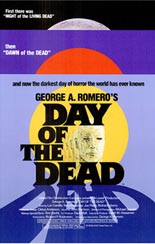 4. Day of the Dead (1985)
4. Day of the Dead (1985)
If The Prowler is an exemplar of some of Savini’s finer work, 1985’s Day of the Dead has to be his finest.
The third in George A. Romero’s Dead cycle, Day may be an acquired taste for some, but it’s Romero’s favorite film of the bunch, and I have to side with ol’ Georgie on this one. Some spotty acting aside, Day is the most complex, intelligent, exciting and just plain goriest of the Dead films. Plus it features Bub – the most memorable zombie in the history of zombie films and certainly the most tragic.
In Day, Savini takes bloodletting to a whole new level. Scenes such as a zombie getting up from a table and spilling his innards out like a dumped over bowl of raspberry Jell-O, another zombie’s head getting cleaved in half with a shovel and a soldier’s re-animated severed head are just the tip of the unsavory offerings on display. The final act is a gorehound’s delight; a bountiful cornucopia of blood, guts and viscera. To wit, Captain Rhode’s last stand, when the blowhard soldier is descended upon by dozens of the living dead. They rip him in half and tear his torso open as easily as opening a bag of potato chips. His lower extremities are dragged away while his insides become his outsides. Simply one of the best gore scenes in horror history.
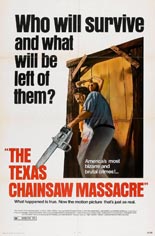 5. The Texas Chain Saw Massacre (1974)
5. The Texas Chain Saw Massacre (1974)
The whack of the sledgehammer heard ’round the world!
What can be said about Tobe Hooper’s 1974 uber-classic that hasn’t already been said? Like Night of the Living Dead before it and Psycho before that, TCM redefined what horror could be. Tense, unnerving, gritty and the complete antithesis of a safe “Hollywood” horror movie, TCM inspired director John Landis (An American Werewolf in London) to say, “When you’re watching a Hitchcock movie … you are in suspense as the direct result of being in the hands of a master … whereas in [The Texas Chain Saw Massacre] … you’re watching it and you’re not in the hands of a master – you’re in the hands of a maniac!”
TCM’s kills are harrowing, but the most shocking of the bunch is so effective because of how bloody (although, surprisingly there’s very little sanguinity in the original TCM) quick and matter-of-fact it is.
Young Kirk had no idea what grisly fate would soon befall him when he decided to trespass and enter into the abode of the Slaughter family (later renamed Sawyer in subsequent sequels.) He was just looking for a little gas and maybe wished to satiate a bit of curiosity. He went through the unlocked door and inquired as to whether anyone was home. Perhaps the animalistic noises and ungodly squeals emanating from the room just steps ahead should have convinced Kirk to reconsider going further. Unfortunately, they didn’t. Kirk pressed on, and in a flash, was besieged by href=”http://www.flickattack.com/2013/10/reading-material-chain-saw-confidential-how-we-made-the-worlds-most-notorious-horror-movie/” target=”new”>a hulking monster of a man clad in a filthy, bloodstained apron who was wearing a mask stitched together from human flesh. Kirk barely had a chance to register any sort of reaction before the sledgehammer came down. Kirk collapsed in a heap, a twitching, gesticulating mess. Another whack for good measure and Kirk was done for. The beast then dragged Kirk into his personal abattoir and ferociously slammed the heavy door shut.
The entire scene described above lasts all of 27 seconds. Perhaps the most grueling 27 seconds in the annals of the genre. —Jeff Kirschner
